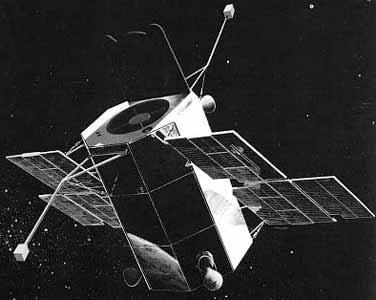Thank you very much for visiting Gunter's Space Page. I hope that this site is useful and informative for you.
If you appreciate the information provided on this site, please consider supporting my work by making a simple and secure donation via PayPal. Please help to run the website and keep everything free of charge. Thank you very much.
OAO 1

OAO 1 [NASA]
OAO 1 (Orbiting Astronomical Observatory 1) was a solar-cell-powered satellite instrumented to make precision astronomical observations and to measure the absorption and emission characteristics of the stars, planets, nebulae, and the interplanetary and interstellar media from visible to gamma-ray regions. The stabilization system permitted three axes a pointing accuracy of 1 arc minute after the star tracker acquired a guide star. The control system permitted an ultimate pointing accuracy of 0.1 arc second.
OAO 1 carried following instruments:
- Broadband UV Photometry
- Gamma-Ray Telescope
- X-Ray Proportional Counter
- Gamma-Ray Telescope
OAO 1 was launched in a nominal nearly perfect circular orbit and operate as planned for the first 7 min after separation. Suqsequent high voltage arcing and battery depletion caused the mission to be terminated as a failure after 20 orbits without activating the experiments. Major problems were attributed to a failure in the power supply system and to high volatage arcing in the star trackers.
| Nation: | USA |
|---|---|
| Type / Application: | Astronomy, UV |
| Operator: | NASA |
| Contractors: | Grumman Aerospace Corp. |
| Equipment: | |
| Configuration: | |
| Propulsion: | |
| Power: | 2 deployable fixed solar arrays, batteries |
| Lifetime: | |
| Mass: | 1774 kg |
| Orbit: | 783 km × 793 km, 35.0° |
| Satellite | COSPAR | Date | LS | Launch Vehicle | Remarks | |
|---|---|---|---|---|---|---|
| OAO 1 (OAO A) | 1966-031A | 08.04.1966 | CC LC-12 | Atlas-SLV3B Agena-D |
References:
- NSSDC Master Catalog: OAO 1
